Despite the fact that the market is constantly replenished with various technologies that improve video and audio equipment, there are traditional devices that do not require upgrades and provide good signal transmission. One such technology is the TV socket. For it to work properly, you need to figure out how to install a television outlet, how to connect a television cable to an outlet, and in what sequence all operations should be performed.
How to choose a television outlet
Modern TVs are versatile and functional devices that transmit a video signal and are a separate part of multimedia systems. You can watch hundreds of TV channels, videos, photos, use the Internet, and also connect game consoles to them.
At the same time, due to the heavy load exerted on the router while the TV is working, wireless connection is far from the most reliable option, so many prefer to use the classic version - a standard socket for the antenna.
The choice of modules that can be built into the wall is quite extensive. The most common brands are Schneider Electric, IEK, Gira and Legrand. Products manufactured by these manufacturers are distinguished by a well-thought out appearance, the use of durable materials, as well as ease of installation.
Television equipment is installed in a slightly different way compared to standard electric points, and therefore it must be approached correctly. Even the sockets and cables, which are the main components, are different here.
There are different design options for the outlet for the antenna cable, even among models from a particular manufacturer, but the operation of the device does not have any fundamental differences.
Before you connect the antenna outlet, you should understand what types are available on the market and how to make a choice in a particular situation. In order not to experience difficulties in the available modifications, manufacturers note three main categories:
- simple;
- terminal;
- checkpoints.
The names of the categories fully correspond to the functionality of each device.
Composing a standard circuit that uses one module with independent operation, a simple outlet is required. It has fundamental differences from the terminal, and therefore, when visiting a store, you should indicate the type of device you need.
If a single TV is installed in the room, to which a single cable is required, this option is the only solution. If there are several appliances in the house, but they work through a standard splitter, you can also use simple sockets.
The design of the passage product is significantly different. Such an outlet with an antenna is more like a tee with two parallel outputs and a single input. The outputs have different purposes: one of them connects a video device to the TV, and the second is for a cable that connects to another TV or a power outlet. In this case, the circuit with feed-through modules always provides for the use at the end of a terminal outlet.
If a large number of loop-through modules are involved in the chain, this can adversely affect signal strength. To avoid this problem, it is recommended to use no more than four pieces.
What is the difference between antenna cable
In order to ensure high-quality connection of the TV, in addition to the correct choice of sockets, you should purchase a coaxial cable.Unlike a simple two-wire or three-wire wire, this cable uses a single core through which the television signal is transmitted, as well as a protective shield that protects the stream from exposure to electromagnetic fields.
Visually, it looks like a thick elastic wire with a circular cross section, which in most cases is surrounded by black or white PVC insulation. When installing the cable indoors, it makes no difference what color the external insulation is.
As an example, we can cite several of the most common types of cable that are used when laying wires under plaster or other types of finishes:
- RG-6 (also suitable for outdoor installation);
- SAT 50;
- RG-11.
When buying a cable, special attention should be paid to the strength of its sheath. If the product will be delivered to the place of use on its own, during transportation, try not to bend it, since it is possible to violate the integrity of the braid.
Wiring diagrams
Two standard connection schemes are used - serial (which is also called a "loop") and parallel ("star"). There are also several other laying technologies, but they all represent different variations and combinations of these two solutions. By themselves, they are similar to conventional electrical circuits, but at the same time they are distinguished by a lower voltage.
Parallel
This technology involves the use of several independent lines. This option will not work if the apartment has a single TV. If video receivers are located in almost every room, to connect them together to one cable, which will go from the broadcast antenna or shield, you will need a special signal dispenser - splitter or splitter. The distributor is a kind of switching organizer, in which one input is designed to connect an antenna cable to it, and through the outputs the received signal is transmitted to TVs.
The advantage of this connection technology is a high-quality signal, the power of which is often reduced due to the use of bushing sockets. When installing the splitter, you can fix it in any convenient place, making it then easier to organize branches throughout the apartment. If in the end one of the process cables breaks down, the network will not work less efficiently.
It also provides the possibility of using the "star" circuit, upgraded by the amplifier, due to which the signal attenuation is reduced. The standard power supply provides for the use of two or three receivers, but since there are often more of them, it is better to install an amplifier to compensate for the resulting drawback and ultimately get a better signal.
When using parallel connection simple or terminal sockets are used. The latter should be installed to eliminate interference if one of the TVs does not turn on very often. The main difference from the simple ones in this case is the presence of wave impedance balancing the signal.
Sequential

Such a scheme is notable for its low cost, but the quality is inferior. Previously, it was common, but with the introduction of new digital technologies, popularity declined, since they mainly work through parallel connection.
The "loopback" scheme can be used only in one situation - if the apartment has an analog TV, and in the near future no changes are planned.
Pass-through modules use special filters that drown out the television signal after it is reflected.The absence of such a filter is not difficult to determine, since a characteristic ripple appears on the screen. When choosing such products, you need to pay attention to two main characteristics:
- Pass attenuation. The parameter must be in the range of 1.5 to 5 dB.
- Branch attenuation. 10 to 15 dB.
Better to buy devices that have lower rates.
With an increase in the total number of connections, the signal quality is noticeably reduced, even if an amplifier or a modern automatic control system is installed in the network. Therefore, if 4-5 receivers are installed in the apartment, in any case, a parallel circuit will be the best solution.
You should carefully read the contract concluded with the provider. Often, companies limit users to the number of points set, for each additional penalty is provided.
Installation procedure for a standard TV socket
Before performing the installation, it is necessary to conduct the cable and mask it under the plaster or in the cable channel.
- Drill makes a hole in the wall.
- A socket is inserted into the hole, from which the cable will exit no more than 15 cm.
- The socket housing is disassembled into parts.
- The cable is inserted in the direction of the arrow, and then secured with a special clip.
- The design is checked by the tester to eliminate the risk of a short circuit due to inadvertent contact between the braid and the conductor.
As a result, there will be no exposed connectors or wires on the wall.
Star Connection
 This connection has several differences:
This connection has several differences:
- First, a splitter is installed, and only then sockets.
- Each output of the splitter is connected to a cable that ends with the installation of a terminal or simple outlet.
- When installing simple modules, do not forget that they do not include the use of filters.
When using such a scheme, it is worth tracking the frequency, since in accordance with standards it should be in the range of 40-1000 MHz.







